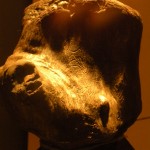Many early winter snowflakes are large and fluffy; these are the opposite. It is like a fine mist of tiny ice droplets, not much more than a cold rain, and certainly not large enough to qualify as a flake. The storm is slowing, having left a few inches of snow on the ground over the past 24 hours. It’s as warm as it’s been in a week, right near the freezing threshold. The icy mist somehow doesn’t feel very cold on my skin. I am wearing only a pair of shorts, deliberately experiencing “exposure to the elements.” It amuses me that this phrase is actually a category on a coroner’s death report, given that exposing myself to the elements is a foundational practice for me. I am fully aware, as a domesticated human, that if I were to stay in these conditions — shoeless & shirtless in below-freezing temperatures at the tail end of a snowstorm — for too long that it would claim my life. It is a way of relating to nature, to the ecosystem around me, and to this storm.
Here I am. I feel you on my skin. I feel your power, but rather than overwhelming me, it is energizing me. I feel the cold air blowing through the hair on my body. I feel the moisture condensing on my skin, and the fire of my breath blowing its being back at the storm. I stand, barefoot, in the same spot long enough to feel all the snow underneath melt away, until finally my bare feet are once again directly on the earth.
It is the same power I felt last night when the storm began. I was sharing space with some dear friends, celebrating the new calendar year with a fireside and a sumbl. We passed a drinking horn filled with spruce mead (originally brewed with wild spring Water) and and shared some Fire-roasted moose meat (a creature of Earth), while filling the Air with our toasts and hails for the gods, the ancestors, the spirits of place, and one another.
One of my foundational practices and concepts is working with the elements in this way. What started nearly 2 decades ago as a very abstract and arbitrary symbolism has evolved into a simple but coherent conceptual map, showing that all that exists contain of the 4 elemental drives or forces. Aligning ourselves with these elements is generally a simple matter of going outside, with the right mindset and a focused and attentive desire to relate with what is all around us. The elements are a wellspring of energy we can tap into, increasing the quality (and in all likelihood, the quantity) of our lives.
Early on, I learned to associate the elements with the 4 suits of the Tarot, which are the same as the Hallows, or the 4 Treasures of the Tuatha Dé Danann: the knife/sword, the wand/rod/spear, the cup/cauldron, and the stone. Over time, it slowly began to dawn on me that these symbols and associations are not arcane or arbitrary. For our ancestors, the Hallows were not ritualistic, abstract or arbitrary props for metaphysical activities. They were everyday, essential tools that allowed them to live with the land, to subsist in relationship with nature. Living in harmony with the elements was their practical ethos, and for the past several years, I have tried to do the same.
In addition to Air, Earth, Fire, and Water, our ancestors also recognized a fifth element, a quintessence. Some have called it “spirit” or “aether,” but for me it is more akin to Chi, or Prana. I think it is not unlike what the Druids call Awen. It is what flows when connection is present. This quintessence is the key to my elemental practice: the goal is always to connect to the elements in a way that maximizes this flow, this chi, this quintessence.
The most immediate manifestation of Earth into our daily lives is food. All life on this planet is built to extract nutrients from the earth, whether it is the root of a plant, a mycelial network in the forest floor, or organisms that feed upon other organisms growing on the surface of the planet. Therefore, I had to learn what eating good food meant, which was quite a journey in itself.
Air is more literal, in the sense that we need air to survive. We can can go 3 weeks without food, 3 days without water, 3 hours without shelter/fire, but only 3 minutes without air. For many people today, especially people in urban areas or who spend little time outside, getting good air can be a challenge.
Water, like Air, is also more literal in the sense that we are water beings and need to drink water regularly to survive. And like Air, the ability of a lot of creatures on this planet to access quality water is limited.
Despite this, I actually think our culture’s relationship with Fire might be the most out of balance, given the amount of industrial combustion taking place, and given that gazing into a small fire — which was once a nightly occurrence for humans — is now seen as a luxury for most of us. Instead, many of us spend hours each day gazing into artificial fire-screens projecting text and images almost directly into our consciousness.
I had to start thinking about what it meant to be in right relationship with each of these elements. I will continue this conversation in my next few posts.

















